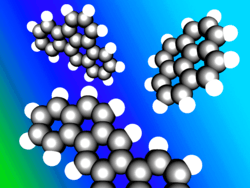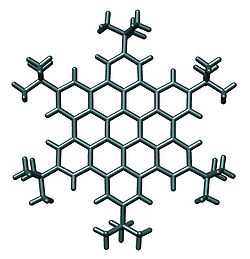Polycyclic aromatic hydrocarbon


Polycyclic aromatic hydrocarbons (PAHs, also polyaromatic hydrocarbons) are hydrocarbons—organic compounds containing only carbon and hydrogen—that are composed of multiple aromatic rings (organic rings in which the electrons are delocalized). Formally, the class is further defined as lacking further branching substituents off of these ring structures. Polynuclear aromatic hydrocarbons (PNAs) are a subset of PAHs that have fused aromatic rings, that is, rings that share one or more sides. Though poly- in these cases literally means "many", there is precedence in nomenclature for beginning this class and subclass with the two ring cases, where naphthalene would therefore be considered a simple example; beginning at three rings, examples include anthracene and phenanthrene.
PAHs are neutral, nonpolar molecules; they are found in fossil fuels (oil and coal) and in tar deposits, and are produced, generally, when insufficient oxygen or other factors result in incomplete combustion of organic matter (e.g., in engines and incinerators, when biomass burns in forest fires, etc.). PAHs can also be found at high levels in cooked foods, e.g., in meat cooked at high temperatures over open flame. Benzo[a]pyrene is a well-researched example of a coal tar PAH (see image) whose metabolites are mutagenic and highly carcinogenic; as a class, benzopyrenes, a ring fusion between monocyclic benzene and tetracyclic pyrene rings, result from incomplete combustion at temperatures between 300 °C (572 °F) and 600 °C (1,112 °F).
PAHs may also be abundant in the universe, and are conjectured to have formed as early as the first couple of billion years after the Big Bang, in association with formation of new stars and exoplanets. Some studies suggest that PAHs account for a significant percentage of all carbon in the universe, and PAHs are discussed as possible starting materials for abiologic syntheses of materials required by the earliest forms of life.
Critically, as noted, PAHs have been identified as carcinogenic and mutagenic (as well as teratogenic), and are considered pollutants of concern for the potency of potential adverse health impacts; the same holds true of their presence at significant levels over time in human diets.
Nomenclature, structure, properties
Structure and properties
As noted, poly- literally means "many", but there is precedence in nomenclature for beginning the PAH class and subclass with the two ring cases (e.g., biphenyl and naphthalene); beginning at three fused aromatic rings, the simplest PAHs are phenanthrene and anthracene.[1] Smaller molecules, such as benzene, are not PAHs, and PAHs are not generally considered as containing heteroatoms or carry substituents.[2] Hence, PAHs may contain four-, five-, six- or seven-member rings; those with five or six are most common. The following are PAH examples with larger numbers of rings:
- Examples of PAH compounds
PAHs composed only of six-membered rings are called alternant PAHs, which include benzenoid PAHs. (See also the topic of polyhexes, where the theory of planar figures composed by conjoining regular hexagons of identical size is considered.) PAHs containing up to six fused aromatic rings are often known as "small" PAHs, and those containing more than six aromatic rings are called "large" PAHs. The bulk of research on PAHs has been on small PAHs, due to their availability. Large PAHs are found as combustion products, but at lower levels than the small PAHs (believed due to the kinetic limitation of their production through addition of successive rings). In addition, many more isomers are possible for the larger PAHs, leading to lower frequency of occurrence of individual large PAH structures.
The biological activity and occurrence of the large PAHs appears to be a continuation of the trends and effects seen for small PAHs.
Aqueous solubility of PAHs decreases approximately one order of magnitude for each additional ring.
Occurrence and pollution

Polycyclic aromatic hydrocarbons are lipophilic, meaning they mix more easily with oil than water. The larger compounds are less water-soluble and less volatile. Because of these properties, PAHs in the environment are found primarily in soil, sediment, and oily substances, as opposed to in water or air. However, they are also a component of concern in particulate matter suspended in air.
Natural crude oil and coal deposits contain significant amounts of PAHs, arising from chemical conversion of natural product molecules, such as steroids, to aromatic hydrocarbons. They are also found in processed fossil fuels, tar, and various edible oils.[4] In a study evaluating the genotoxic and carcinogenic risks associated with the consumption of repeatedly heated coconut oil (RCO), one of the commonly consumed cooking and frying medium, it was concluded that dietary consumption of RCO can cause a genotoxic and preneoplastic change in the liver.[5]
PAHs are one of the most widespread organic pollutants. In addition to their presence in fossil fuels they are also formed by incomplete combustion of carbon-containing fuels such as wood, coal, diesel, fat, tobacco, and incense.[6] Different types of combustion yield different distributions of PAHs in both relative amounts of individual PAHs and in which isomers are produced. Thus, coal burning produces a different mixture than motor-fuel combustion or a forest fire, making the compounds potentially useful as indicators of the burning history. Hydrocarbon emissions from fossil fuel-burning engines are regulated in developed countries.[7] Certain species of bacteria are capable of degrading polycyclic hydrocarbons, such as Kordiimonas gwangyangensis.[8]
PAH chemicals are often linked to oil spills. Following the massive Deepwater Horizon oil spill, scientists found PAH levels to be 40 times higher than before the area was affected. The researchers said that the compounds can enter the food chain through organisms such as plankton or fish.[9][10][11] The mechanism by which oil spill PAHs poison fish was reported in a 2014 paper in the journal Science, which found that PAHs kill fish by sending them into cardiac arrest. The study also found even very low concentrations of PAHs can slow fish heartbeats and disrupt the development of fish larvae. The work may have implications for mammals and other forms of vertebrate life.[12]
PAHs are also found in cooked foods. Studies have shown that high levels of PAHs are found, for example, in meat cooked at high temperatures such as grilling or barbecuing, and in smoked fish.[13][14][15]
Human health
The toxicity of PAHs is structure-dependent. Isomers (PAHs with the same formula and number of rings) can vary from being nontoxic to extremely toxic. One PAH compound, benzo[a]pyrene, is notable for being the first chemical carcinogen to be discovered (and is one of many carcinogens found in cigarette smoke). The EPA has classified seven PAH compounds as probable human carcinogens: benz[a]anthracene, benzo[a]pyrene, benzo[b]fluoranthene, benzo[k]fluoranthene, chrysene, dibenz(a,h)anthracene, and indeno(1,2,3-cd)pyrene.
PAHs known for their carcinogenic, mutagenic, and teratogenic properties are benz[a]anthracene and chrysene, benzo[b]fluoranthene, benzo[j]fluoranthene, benzo[k]fluoranthene, benzo[a]pyrene, benzo[ghi]perylene, coronene, dibenz(a,h)anthracene (C
20H
14), indeno(1,2,3-cd)pyrene (C
22H
12), and ovalene.[16]
High prenatal exposure to PAH is associated with lower IQ and childhood asthma.[17] The Center for Children's Environmental Health reports studies that demonstrate that exposure to PAH pollution during pregnancy is related to adverse birth outcomes including low birth weight, premature delivery, and heart malformations. Cord blood of exposed babies shows DNA damage that has been linked to cancer. Follow-up studies show a higher level of developmental delays at age three, lower scores on IQ tests and increased behavioral problems at ages six and eight.[18]
In addition, a 2012 Columbia University study in Environmental Health Perspectives linked prenatal exposure to pollutants and eventual child behavioral outcomes. The study found that exposure to higher levels of PAH was associated with a 24% higher score of anxiety or depression for children ages six to seven than those with low exposure levels. Infants found to have elevated PAH levels in their umbilical cord blood were 46% more likely to eventually score highly on the anxiety/depression scale than those with low PAH levels in cord blood.[19][20]
Agency for Toxic Substances and Disease Registry listings
Although the health effects of individual PAHs are not exactly alike, the following 18 PAHs are considered as a group in this profile issued by the Agency for Toxic Substances and Disease Registry (ATSDR):[21]
Additional PAHs:
Environmental Protection Agency priority pollutants
The United States Environmental Protection Agency (EPA) has designated 32 PAH compounds as priority pollutants. The original 16[22] are listed; they are naphthalene, acenaphthylene, acenaphthene, fluorene, phenanthrene, anthracene, fluoranthene, pyrene, benzo[a]anthracene, chrysene, benzo[b]fluoranthene, benzo[k]fluoranthene, benzo[a]pyrene, dibenz(ah)anthracene, benzo[ghi]perylene, and indeno[1,2,3-cd]pyrene. This list of the 16 EPA priority PAHs is often targeted for measurement in environmental samples.
Detection and optical properties
Detection of PAHs in materials is often done using gas chromatography-mass spectrometry or liquid chromatography with ultraviolet-visible or fluorescence spectroscopic methods or by using rapid test PAH indicator strips.
PAHs possess very characteristic UV absorbance spectra. These often possess many absorbance bands and are unique for each ring structure. Thus, for a set of isomers, each isomer has a different UV absorbance spectrum than the others. This is particularly useful in the identification of PAHs. Most PAHs are also fluorescent, emitting characteristic wavelengths of light when they are excited (when the molecules absorb light). The extended pi-electron electronic structures of PAHs lead to these spectra, as well as to certain large PAHs also exhibiting semi-conducting and other behaviors.
Theoretical aspects
Aromaticity
Although PAHs clearly are aromatic compounds, the degree of aromaticity can be different for each ring segment. According to Clar's rule (formulated by Erich Clar in 1964)[23] for PAHs the resonance structure with the most disjoint aromatic п-sextets—i.e. benzene-like moieties—is the most important for the characterization of the properties.[24]
 |
 |
 |
| Phenanthrene | Anthracene | Chrysene |
|---|
For example, in phenanthrene one Clar structure has two sextets at the extremities, while the other resonance structure has just one central sextet; therefore in this molecule the outer rings are have greater aromatic character whereas the central ring is less aromatic and therefore more reactive. In contrast, in anthracene the resonance structures have one sextet, which can be at any of the three rings, and the aromaticity spreads out more evenly across the whole molecule. This difference in number of sextets is reflected in the UV absorbance spectra of these two isomers; phenanthrene has a highest wavelength absorbance around 290 nm, while anthracene has highest wavelength bands around 380 nm. Three Clar structures with two sextets each are present in chrysene. Superposition of these structures reveals that the aromaticity in the outer rings is greater (each has a sextet in two of the three Clar structures) compared to the inner rings (each has a sextet in only one of the three).
Origins of life
PAHs may be abundant in the universe.[26][27][28][29] They seem to have been formed as early as a couple of billion years after the Big Bang, and are associated with new stars and exoplanets.[30] More than 20% of the carbon in the universe may be associated with PAHs.[30] PAHs are considered possible starting material for the earliest forms of life.[28][30] In January 2004 (at the 203rd Meeting of the American Astronomical Society), it was reported[31] that a team led by A. Witt of the University of Toledo, Ohio studied ultraviolet light emitted by the Red Rectangle nebula and found spectral signatures that suggest the presence of anthracene and pyrene (no other such complex molecules had ever been found in space).[32] This report was considered a controversial hypothesis that as nebulae of the same type as the Red Rectangle approach the ends of their lives, convection currents cause carbon and hydrogen in the nebulae's core to get caught in stellar winds, and radiate outward. As they cool, the atoms supposedly bond to each other in various ways and eventually form particles of a million or more atoms. Witt and his team inferred[31] that PAHs —which may have been vital in the formation of early life on Earth— in a nebula, by necessity they must originate in nebulae.[32]
More recently, fullerenes (or "buckyballs"), have been detected in other nebulae.[33] Fullerenes are also implicated in the origin of life; according to astronomer Letizia Stanghellini, "It's possible that buckyballs from outer space provided seeds for life on Earth."[34] In September 2012, NASA scientists reported results of analog studies in vitro that PAHs, subjected to interstellar medium (ISM) conditions, are transformed, through hydrogenation, oxygenation, and hydroxylation, to more complex organics—"a step along the path toward amino acids and nucleotides, the raw materials of proteins and DNA, respectively".[35][36] Further, as a result of these transformations, the PAHs lose their spectroscopic signature which could be one of the reasons "for the lack of PAH detection in interstellar ice grains, particularly the outer regions of cold, dense clouds or the upper molecular layers of protoplanetary disks."[35][36]
In June 2013, the detection of PAHs in the upper atmosphere of Titan, the largest moon of the planet Saturn, was reported by scientists at IAA-CSIC.[37]
On February 21, 2014, NASA announced a greatly upgraded database[30] for tracking polycyclic aromatic hydrocarbons (PAHs) in the universe. According to scientists, more than 20% of the carbon in the universe may be associated with PAHs, possible starting materials for the formation of life. PAHs seem to have been formed as early as "a couple of billion years" after the Big Bang, are widespread throughout the universe,[26][27][28] and are associated with new stars and exoplanets.[30]
In March 2015, NASA scientists reported that, for the first time, complex DNA and RNA organic compounds of life, including uracil, cytosine and thymine, have been formed in the laboratory under outer space conditions, using starting chemicals, such as pyrimidine, found in meteorites. Pyrimidine, like polycyclic aromatic hydrocarbons (PAHs), the most carbon-rich chemical found in the universe, may have been formed in red giants or in interstellar dust and gas clouds, according to the scientists.[38]
See also
| Wikimedia Commons has media related to Polycyclic aromatic hydrocarbons. |
References
- ↑ G.P. Moss IUPAC nomenclature for fused-ring systems
- ↑ Fetzer, J. C. (2000). "The Chemistry and Analysis of the Large Polycyclic Aromatic Hydrocarbons". Polycyclic Aromatic Compounds (New York: Wiley) 27 (2): 143. doi:10.1080/10406630701268255. ISBN 0-471-36354-5.
- ↑ Herwig, P. T.; Enkelmann, V.; Schmelz, O.; Müllen, K. (2000). "Synthesis and Structural Characterization of Hexa-tert-butyl- hexa-peri-hexabenzocoronene, Its Radical Cation Salt and Its Tricarbonylchromium Complex". Chemistry: A European Journal 6 (10): 1834–9. doi:10.1002/(SICI)1521-3765(20000515)6:10<1834::AID-CHEM1834>3.0.CO;2-L.
- ↑ Roy, G. M. (1995). Activated carbon applications in the food and pharmaceutical industries. CRC Press. p. 125. ISBN 1-56676-198-0.
- ↑ Srivastava, S.; Singh, M.; George, J.; Bhui, K. et al. (2010). "Genotoxic and carcinogenic risks associated with the dietary consumption of repeatedly heated coconut oil" (PDF). British Journal of Nutrition 104 (9): 1343–52. doi:10.1017/S0007114510002229. PMID 20687968.
- ↑ "Incense link to cancer". BBC News. 2001-08-02.
- ↑ For example, EPA regulations for small engines are at 40 CFR §90.103; see emission standard for more information.
- ↑ Kwon, K. K.; Lee, H. S.; Yang, S. H.; Kim, S. J. (2005). "Kordiimonas gwangyangensis gen. nov., sp. nov., a marine bacterium isolated from marine sediments that forms a distinct phyletic lineage (Kordiimonadales ord. nov.) in the ‘Alphaproteobacteria’". International Journal of Systematic and Evolutionary Microbiology 55 (Pt 5): 2033–7. doi:10.1099/ijs.0.63684-0. PMID 16166706.
- ↑ Schneyer, Joshua (27 September 2010). "U.S. oil spill waters contain carcinogens: report". Reuters. Retrieved 2010-10-01.
- ↑ Ortmann, A. C.; Anders, J.; Shelton, N.; Gong, L. et al. (2012). "Dispersed Oil Disrupts Microbial Pathways in Pelagic Food Webs". PLOS ONE 7 (7): e42548. Bibcode:2012PLoSO...742548O. doi:10.1371/journal.pone.0042548. PMC 3409195. PMID 22860136.
- ↑ "Oil from Deepwater Horizon disaster entered food chain in the Gulf of Mexico". Sciencedaily.com. 20 March 2012. doi:10.1029/2011GL049505. Retrieved 2012-06-01.
- ↑ Sahagun, L. (February 13, 2014). "Toxins released by oil spills send fish hearts into cardiac arrest". Los Angeles Times. Retrieved 17 February 2014.
- ↑ "Polycyclic Aromatic Hydrocarbons – Occurrence in foods, dietary exposure and health effects" (PDF). European Commission, Scientific Committee on Food. December 4, 2002.
- ↑ Larsson, B. K.; Sahlberg, G. P.; Eriksson, A. T.; Busk, L. A. (1983). "Polycyclic aromatic hydrocarbons in grilled food". Journal of Agricultural and Food Chemistry 31 (4): 867–73. doi:10.1021/jf00118a049. PMID 6352775.
- ↑ "Polycyclic Aromatic Hydrocarbons (PAHs)". Agency for Toxic Substances and Disease Registry. 1996.
- ↑ Luch, A. (2005). The Carcinogenic Effects of Polycyclic Aromatic Hydrocarbons. London: Imperial College Press. ISBN 1-86094-417-5.
- ↑ "Exposure to Common Pollutant in Womb Might Lower IQ". US News & World Report. Retrieved 13 October 2014.
- ↑
- ↑ "Prenatal Polycyclic Aromatic Hydrocarbon (PAH) Exposure and Child Behavior at Age 6-7". JournalistsResource.org, retrieved 4 April 2012
- ↑ Perera, F. P.; Tang, D.; Wang, S.; Vishnevetsky, J. et al. (2012). "Prenatal Polycyclic Aromatic Hydrocarbon (PAH) Exposure and Child Behavior at age 6-7". Environmental Health Perspectives 120 (6): 921–26. doi:10.1289/ehp.1104315.
- ↑ "ATSDR Home". Retrieved 13 October 2014.
- ↑ Yan, J; Wang, L; Fu, PP; Yu, H (10 January 2004). "Photomutagenicity of 16 polycyclic aromatic hydrocarbons from the US EPA priority pollutant list". Mutation research 557 (1): 99–108. doi:10.1016/j.mrgentox.2003.10.004. PMC 2713671. PMID 14706522.
- ↑ Clar, E. (1964). Polycyclic Hydrocarbons. New York: Academic Press. LCCN 63012392.
- ↑ Portella, G.; Poater, J.; Solà, M. (2005). "Assessment of Clar's aromatic π-sextet rule by means of PDI, NICS and HOMA indicators of local aromaticity". Journal of Physical Organic Chemistry 18 (8): 785–91. doi:10.1002/poc.938.
- ↑ Staff (28 July 2010). "Bright Lights, Green City". NASA. Retrieved 13 June 2014.
- ↑ 26.0 26.1 Carey, Bjorn (October 18, 2005). "Life's Building Blocks 'Abundant in Space'". Space.com. Retrieved March 3, 2014.
- ↑ 27.0 27.1 Hudgins, D. M.; Bauschlicher, C. W. Jr.; Allamandola, L. J. (2005). "Variations in the Peak Position of the 6.2 μm Interstellar Emission Feature: A Tracer of N in the Interstellar Polycyclic Aromatic Hydrocarbon Population". Astrophysical Journal 632 (1): 316–32. Bibcode:2005ApJ...632..316H. doi:10.1086/432495. Retrieved March 3, 2014.
- ↑ 28.0 28.1 28.2 Allamandola, Louis et al. (April 13, 2011). "Cosmic Distribution of Chemical Complexity". NASA. Retrieved March 3, 2014.
- ↑ Clavin, Whitney (February 10, 2015). "Why Comets Are Like Deep Fried Ice Cream". NASA. Retrieved February 10, 2015.
- ↑ 30.0 30.1 30.2 30.3 30.4 Hoover, R. (21 February 2014). "Need to Track Organic Nano-Particles Across the Universe? NASA's Got an App for That". NASA. Retrieved 22 February 2014.
- ↑ 31.0 31.1 Battersby, S. (2004). "Space molecules point to organic origins". New Scientist. Retrieved 2009-12-11.
- ↑ 32.0 32.1 Mulas, G.; Malloci, G.; Joblin, C.; Toublanc, D. (2006). "Estimated IR and phosphorescence emission fluxes for specific polycyclic aromatic hydrocarbons in the Red Rectangle". Astronomy and Astrophysics 446 (2): 537–49. arXiv:astro-ph/0509586. Bibcode:2006A&A...446..537M. doi:10.1051/0004-6361:20053738.
- ↑ García-Hernández, D. A.; Manchado, A.; García-Lario, P.; Stanghellini, L. et al. (2010). "Formation Of Fullerenes In H-Containing Planatary Nebulae". The Astrophysical Journal Letters 724 (1): L39–43. arXiv:1009.4357. Bibcode:2010ApJ...724L..39G. doi:10.1088/2041-8205/724/1/L39.
- ↑ Atkinson, N. (2010-10-27). "Buckyballs Could Be Plentiful in the Universe". Universe Today. Retrieved 2010-10-28.
- ↑ 35.0 35.1 Staff (September 20, 2012). "NASA Cooks Up Icy Organics to Mimic Life's Origins". Space.com. Retrieved September 22, 2012.
- ↑ 36.0 36.1 Gudipati, M. S.; Yang, R. (2012). "In-Situ Probing Of Radiation-Induced Processing Of Organics In Astrophysical Ice Analogs—Novel Laser Desorption Laser Ionization Time-Of-Flight Mass Spectroscopic Studies" (PDF). The Astrophysical Journal Letters 756 (1): L24. Bibcode:2012ApJ...756L..24G. doi:10.1088/2041-8205/756/1/L24.
- ↑ López-Puertas, Manuel (June 6, 2013). "PAH's in Titan's Upper Atmosphere". CSIC. Retrieved June 6, 2013.
- ↑ Marlaire, Ruth (3 March 2015). "NASA Ames Reproduces the Building Blocks of Life in Laboratory". NASA. Retrieved 5 March 2015.
External links
- ATSDR - Toxicity of Polycyclic Aromatic Hydrocarbons (PAHs) U.S. Department of Health and Human Services
- Fused Ring and Bridged Fused Ring Nomenclature
- Database of PAH structures
- Cagliari PAH Theoretical Database
- NASA Ames PAH IR Spectroscopic Database
- National Pollutant Inventory: Polycyclic Aromatic Hydrocarbon Fact Sheet
- Understanding Polycyclic Aromatic Hydrocarbons NASA Spitzer Space Telescope
- Astrobiology magazine Aromatic World An interview with Professor Pascale Ehrenfreund on PAH origin of life. Accessed June 2006
- Oregon State University Superfund Research Center focused on new technologies and emerging health risks of Polycyclic Aromatic Hydrocarbons (PAHs)
- Polycyclic Aromatic Hydrocarbons (PAHs)--EPA Fact Sheet. U.S. Environmental Protection Agency, Office of Solid Waste, January 2008.
| ||||||||||||||||||||||
| ||||||||||||||||||||||||||||||||||||||||||||||||||||||||||||||||||||||||||||||||||||||||||||||||||||||||
| |||||||||||||||||||||||||||||||||||||||||||||||||||||||||





perilene.png)



